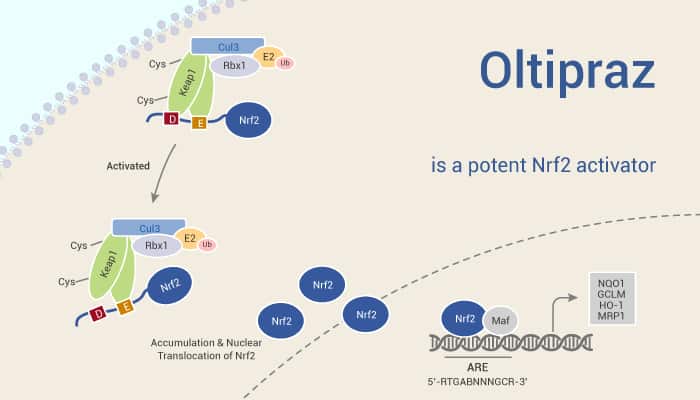Multidrug resistance-associated proteins (Mrps) are ATP-dependent transporters involved in the efflux of a vast number of endogenous and exogenous chemicals.
GSH is one of the liver’s main defenses against oxidative stress because of the conjugating, scavenging, and reducing capabilities of this molecule. GSH is essential to cellular defense against oxidative stress; hepatocyte-specific deletion of Gclc seemingly offers an excellent model for the study of oxidative stress-related mechanisms.
Oltipraz is a potent Nrf2 activator.

Nrf2 serves as a cellular sensor for oxidative stress. During the oxidative challenge, the modification of Keap1 sulfhydryl groups results in the release and nuclear translocation of Nrf2.
Oltipraz and butylated hydroxyanisole can induce hepatic Mrp transporters and whether that induction is through the Nrf2 transcriptional pathway. Livers from hepatocyte-specific glutamate-cysteine ligase catalytic subunit–null mice have increased nuclear Nrf2 levels, marked gene, and protein induction of the Nrf2 target gene NAD(P)H:quinone oxidoreductase 1, as well as Mrp2, Mrp3, and Mrp4 expression. The treatment of wild-type and Nrf2-null mice with oltipraz and butylated hydroxyanisole demonstrated that the induction of Mrp2, Mrp3, and Mrp4 is Nrf2-dependent.
Oltipraz inhibits HIF-1α activity and HIF-1α-dependent tumor growth, which may result from a decrease in HIF-1α stability through S6K1 inhibition in combination with an H<sub>2</sub>O<sub>2</sub>-scavenging effect. Oltipraz treatment also inhibits HIF-1α activation stimulated by either hypoxia or CoCl<sub>2</sub>. The compound is a cancer chemopreventive agent and has an inhibitory effect on angiogenesis and tumor growth. Oltipraz is also a competitive inhibitor of this cytochrome P450, with an apparent K<sub>i</sub> of 10 μM.
In wild-type mice, hepatic levels of mRNA for all of the genes analyzed significantly increased after Oltipraz treatment. Interestingly, mRNA levels of Nrf2 itself were increased more than 3-fold by Oltipraz treatment.
Reference: